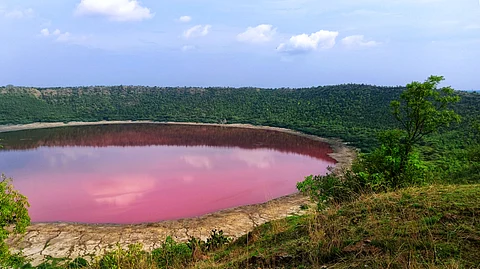

Away from the hullaballoo of the busy tourist circuits, deep inside India, are kilometres-wide, water-filled meteorite-impact craters. They prove that the Big Bang happened, and the debris is still spinning around in space. Populated by hardy bacteria et al., which thrive in their chemical-intensive waters, the crater lakes are fringed by freshwater forests that support unique flora and fauna. Here are three verified impact-crater lakes in Maharashtra, Madhya Pradesh, and Rajasthan, which you must visit.
Located on the Deccan Plateau in the Buldhana district of Maharashtra, the Lonar crater is now a highly saline and alkaline water lake due to no outflow, leading to a concentration of minerals. Micro-organisms such as anaerobes, cyanobacteria, and phytoplankton survive in the lake's harsh environment. The crater was created due to a meteorite impact around 570,000 to 47,000 years ago, and it presents as a hover-backed protrusion in the basalt (volcanic) rock and is an endorheic or closed basin. The lake has been the subject of research for many years by several esteemed institutions in India and abroad. Lonar Crater was declared a wildlife sanctuary since the forest around the lake has 160 species of birds, including the endangered Asian woolly neck (Ciconia episcopus) and common pochard (Aythya ferina). In addition to these, it has 46 species of reptiles, and 12 species of mammals, including the iconic grey wolf (Canis lupus).
Best time to visit: November to February
Entry fee: Nil
By air: The airport at Aurangabad is 140 kilometres away.
By railway: The nearest railway stations are Partur and Jalna.
By road: Regular state transport buses are available from the bus station of Maharashtra State Road Transport Corporation. Or, you can take private transport.
For more information, check the websites Maharashtra Tourism and Ramsar site.
Created about 2,500 million years ago by an asteroid about one kilometre in diameter, Dhala in the Bundelkhand region of Madhya Pradesh's Shivpuri district is one of the oldest impact structures in the world. An Indian geologist, Jayanta K Pati, discovered it.
Named after the village Dhala, the crater is an eroded leftover of the original impact structure, estimated to be at a diameter of 11 kilometres, the largest in Asia. In fact, it is the largest confirmed impact structure reported between the Mediterranean and south-east Asia, claims the discoverer. While a British scientist discovered the Lonar crater, the Dhala crater is the only one discovered in the subcontinent and Far East Asia by an Indian scientist.
Best time to visit: Winter months
Entry fee: Nil
Distances: Dhala is 58 kilometres from Jhansi and 52 kilometres from Babina, both in Uttar Pradesh. It is 72 kilometres from Orchha, and 181 kilometres from Gwalior, both in Madhya Pradesh.
By air: The nearest airport is at Gwalior, which is 110 kilometres away from Jhansi, and 128 kilometres from Orchha.
By railway: The nearest railway stations are Jhansi and Babina.
By road: Regular state transport buses are available, or you can take private transport from Gwalior, Jhansi, Babina, or Orchha.
For more information, check the website.

Around 150 million years ago, a meteorite crashed into what is now the Baran district of Rajasthan and created a crater of about three kilometres in diameter. Eventually, a one-kilometre-long, and 250-metre-wide lake was formed in it. First discovered in 1869 by the Geological Survey of India, the Ramgarh crater is said to have all the signs of an impact crater. Also, its morphological features are more pronounced than those of the Lonar crater. in 2019, a team of geo-scientists from the Geographical Survey of India, or GSI, and the National Trust for Art and Culture Heritage, or INTACH, paid a visit to the Ramgarh crater and conducted more research as to its origins.
Currently, Rajasthan's mines and geology department is planning to recommend the crater site to the International Union of Geo-Heritage (IUGH) to have it declared as an international geo-heritage site. Meanwhile, the archaeological department is strategizing to convert the crater into a tourist site and is looking to create infrastructure for it.
Best time to visit: Winter months
Entry fee: Nil
Distances: Baran is 102 kilometres from Kota, in Rajasthan, and 257 kilometres from Gwalior, in Madhya Pradesh.
By air: The Kota Airport is eight kilometres from the main railway station, and near the Aerodrome Circle, on Jhalawar Road. The other nearest major airports are Jaipur International Airport (256 kilometres away), Udaipur Airport, and Jodhpur Airport.
By railway: Baran station is situated on the Kota-Bina section of Western Central Railways. It is about 67 kilometres from Kota Junction.
By road: Baran is connected with neighbouring districts and with major cities outside Rajasthan. NH 27 (previously NH 76), a part of the East-West Corridor, passes through the district.
For more information, check the website.
